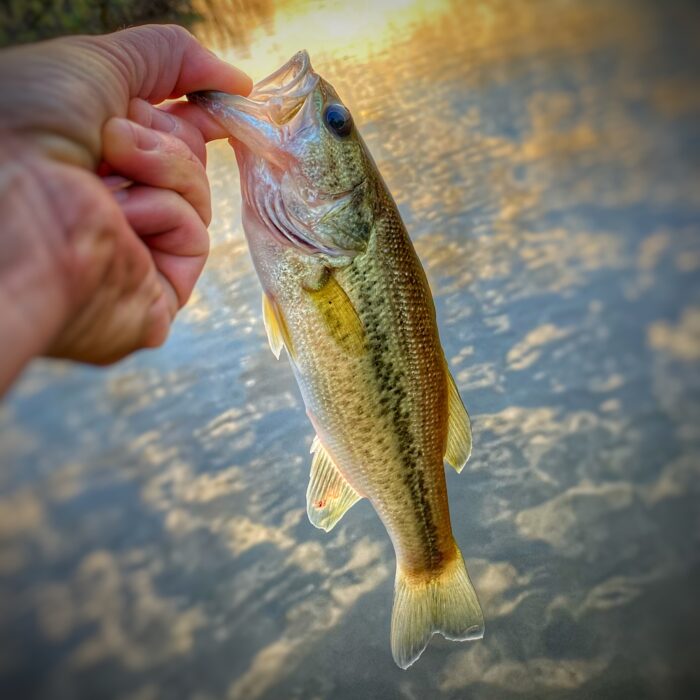This past Spring I hiked a couple of miles in to sleep under a canopy of stars at one of the dispersed, primitive campsites there. After pitching my tent on a little patch of finely crushed granite and setting up camp, I packed my Helinox Chair Zero, along with my favorite ramen and cooking kit, into my then-empty pack to trek over to the nearby lake for a little waterfront dining. “Wildlife pond” is likely a better moniker for the petite body of water. Or, since this is Texas, “tank” if you please. Little man-made or at least made-bigger ponds like this can frequently be found on public lands to provide habitat and watering holes that attract and support area wildlife. They’re most often populated by insects and amphibians. Before heading out, it occurred to me that mosquito repellant might also be good to have on hand so I added the little bottle to my bundle.
I made my way across the levee and around to the opposite side to see if there was a trail leading under the oaks. I had my eye on a little point that jutted out to create a sort of miniature peninsula. Turns out there WAS a trail. Was, being the operative word there. Unfortunately, the February ice storms had done their worst, reducing many large & rather gnarly fallen limbs to a bramble-like labyrinth nearly choking out the access. Even the relatively sleek profile of my pack wasn’t impervious to a few snags, each abruptly halting my forward progress like a dog at the end of its chain. But unlike the dog in an open run, these moments found me already precariously pretzeling myself to weave through the downed branches and avoid any number of other Hill Country flora conspiring and poised to needle me.
Once through the thicket and onto my private island, I set up the backpacking chair and fired up my little rocket stove to boil the water for my meal. The chair is, no doubt, a luxury, but for short overnights, the extra pound on my back is a small toll to pay for the added lounge-ability at camp. Checking my simmering ramen, I found the noodles to be sufficiently noodle-y, sat back, and began to slurp as the golden hour became the Blaue Stunde, the German translation for “Blue Hour.” I was taught to refer to it as such by an Austrian friend I met on a trip to the Czech Republic in my 20s. I first heard it while gazing out over a sea of rich orange terra-cotta roofs in Southern Bohemia as the fading sunset slowly surrendered its warmth to the steely blue that followed, steadily draining them of all color.
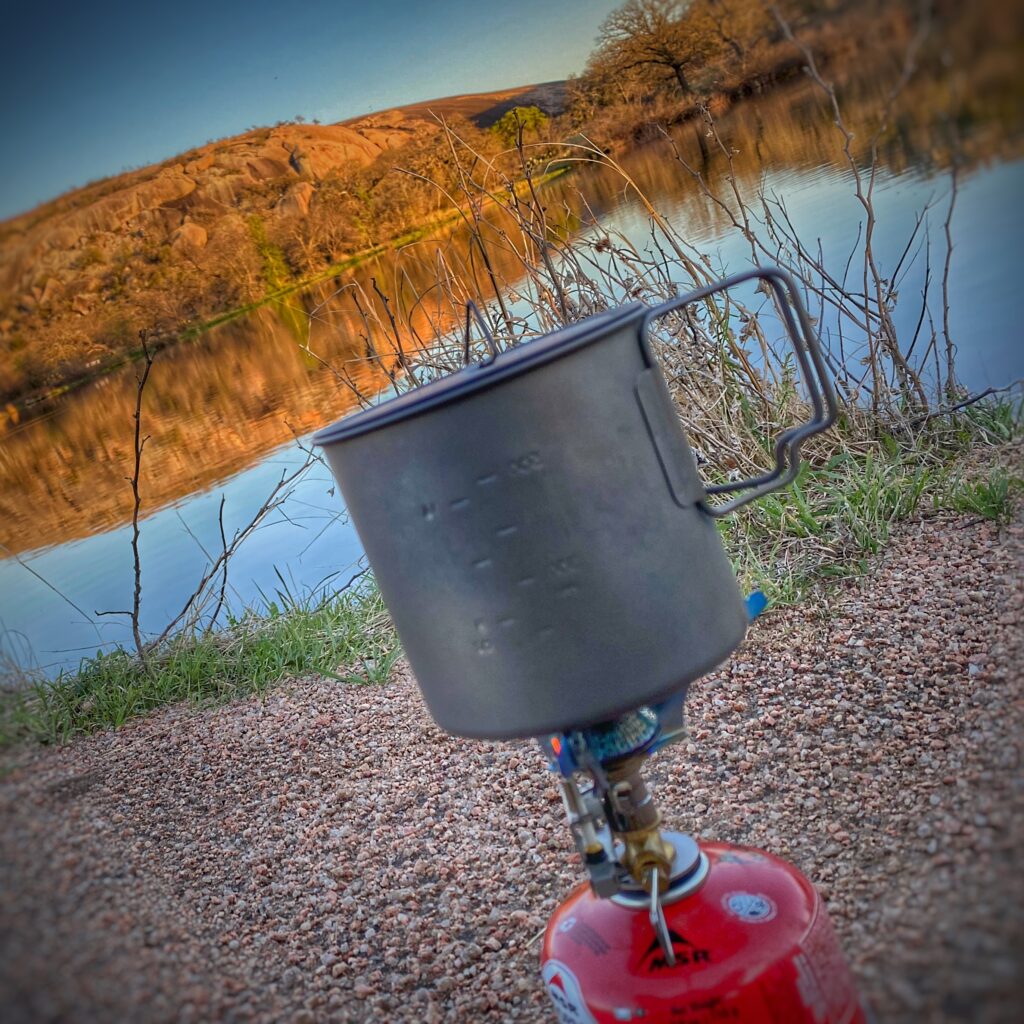
This time, instead of somewhere just north of the Austrian border looking across a horseshoe bend in the Vltava, I sat beside small, still water in the heart of Texas Hill Country more than 5000 miles away from that spot. And in the sliver of day between gold and blue, I came to quickly realized I wasn’t the only one slurping out here. I could have sworn I heard the unmistakable sound of fish rising to feed on the surface of the water. Then, as my eyes focused outwards and caught up with my ears, I began to see it. First a few small circles in the shallows, then a few more, then a virtual outbreak of them all across the top of the water in an honest-to-goodness evening rise. There are fish here, I thought. Hungry ones, devouring a buffet of topwater insects in the mounting dusk. Which, along with a few uncomfortable pinches to my arm, reminded me to apply some of that bug dope I was grateful to have brought along.
After a suitable application, I sat, mouth agape for a few moments. That is, until I had the presence of mind to shut it. It’s one thing to watch fish eat bugs and quite another to do so yourself. I then stood up to achieve a better vantage point from which to witness the spectacle. I suppose it reminded me of the times I had attended modern dance performances—seemingly random movements, naturally fluid and perfectly timed.
At some point, I thought, as I often do when I find myself in such “fishy” situations without a fly rod handy, that the fish were mocking me at my inability to cast to them. That’s such a human thing to do. To stop not only at anthropomorphism (yes, I’m charging extra for that word), but to go even further, making the millennia-old primal feeding habits of another life form somehow a personal snub. In perspective, our sense of superiority really is something. Once I had a proper chuckle, and minor chiding of myself, I settled back into the calming effect of nature’s performance. The fish continued to feast, the crickets began to sing, and the brightest of the stars began to poke through the thinning veil of day.
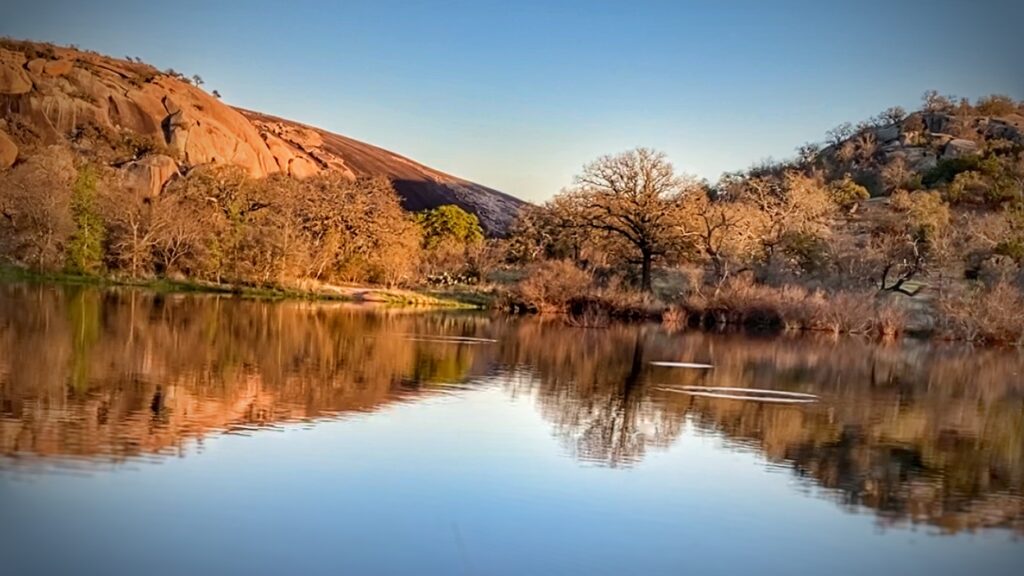
And then it was ending, in a flawless mirror of its beginning. Fewer circles. Then fewer still, until stillness reigned once more. Based on the way they were feeding, these were sunfish. But only by bringing a few to hand could I know which flavors and in what proportions. As I disassembled my featherweight furniture and repacked my ruck for the short walk back to camp, I determined that I would return here at first chance, fly rod in tow, for a little unsanctioned “survey” of these gems.
So there I stood, more than six months later, preparing to make good on a promise made in the blush of Spring. There were a few differences this time. For starters, the slight dampness in the air had long since been replaced by an arid crispness. I was also planning to hike the couple of miles back out to sleep in the #CariVan instead of at a backcountry site. Finally, and most importantly, I would have a fly rod!
With my rod strung up, pack strapped to my back and fedora snugged down across my brow, I was ready to embark. I mistakenly chose a “shortcut” on the way in, thinking I could be fishing sooner. As was demonstrated by this foible on my part, rugged terrain can turn a short distance into a long hike. The scramble over rocks and boulders randomly and precariously placed also had me wishing the trekking pole in my right hand had a twin in my left instead of a fly rod. No harm, though, it was a beautiful trail and required about the same amount of time to traverse as the longer, easier path would have. I’ve always gravitated toward the scenic route, even unconsciously, it would seem.
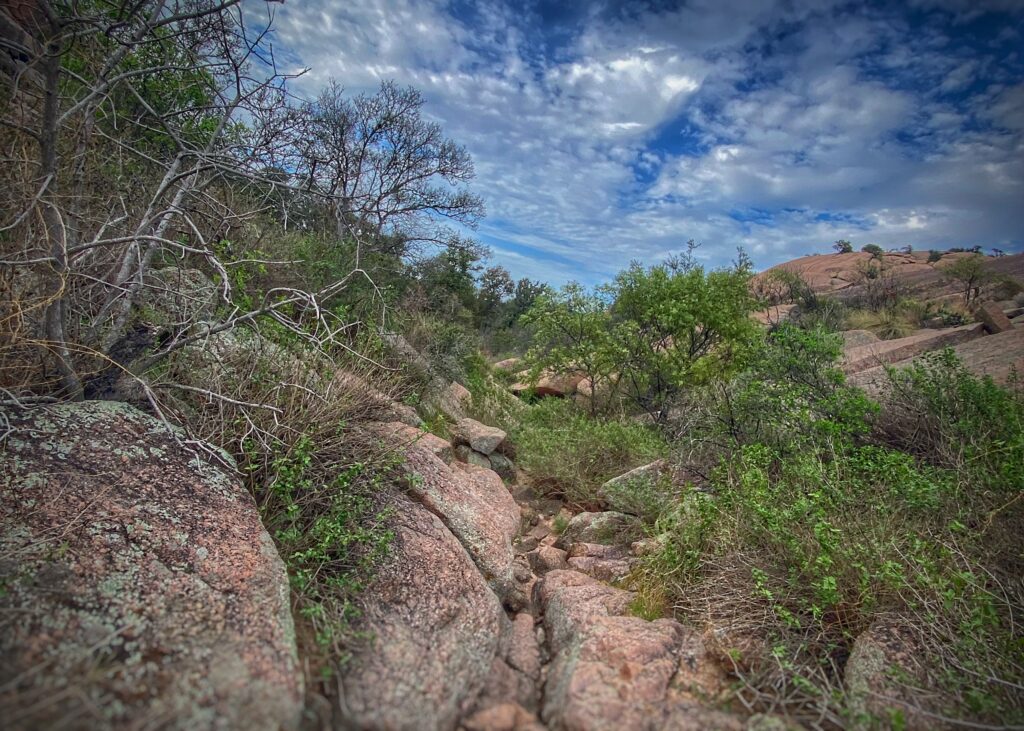
I arrived at water’s edge around 5 pm. The pond was relatively high for October thanks to recent rains, but the overcast skies that were their parting gift made it harder than usual to peer through the water, even with polarized lenses, and I saw no movement while surveying my surroundings. I was able to wade in only a few feet before being halted by a quickly sloping bottom contour. But it was far enough to provide some welcome distance from the grasses, shrubs, and mesquite encroaching at the bank to allow a clear casting lane. From where I stood, there were a few spots where brushy vegetation thrust up from places where a bit of earth had broken above the surface of the shallow flat.
One such island was relatively close by, but the other two would be a pretty substantial reach with a light rod while still trying to make a delicate, accurate cast. Lucky for me, the 8ft 3wt built for me by JP Ross is practically a magic wand and excels in just such a scenario. I tied on a small ant pattern and made a cast that landed the fly a couple of feet away from the brush. Nothing. A few small twitches after the surface disturbance settled and still nothing. I repeated this doomed approach for several minutes. I wasn’t getting the fly close enough. Ants don’t drop out of the sky, after all. I’d have to risk snagging and try to slide the cast in to drop the fly just under the bush above. Its thin branches were low to the waterline but didn’t reach out far from the plant’s base. That meant the fish’s natural feeding zone for a falling terrestrial, and therefore landing zone for my fly, was something akin to a postage stamp.
I stepped as close as I dared to the drop-off, made a couple of false casts, and miraculously landed the tiny foam ant right where I had envisioned. But there was precious little time for self-congratulations as a small splash accompanied by a plopping sound signaled a textbook panfish eat. The lightweight rod bent willingly at the subsequent tug downward and I quickly stripped in my first quarry, a hand-sized green sunfish. After a rapid release, I spent the next 45 minutes or so of fun picking apart the waters around the bushes and pulling multiple sunfish of varying sizes from the dark waters.
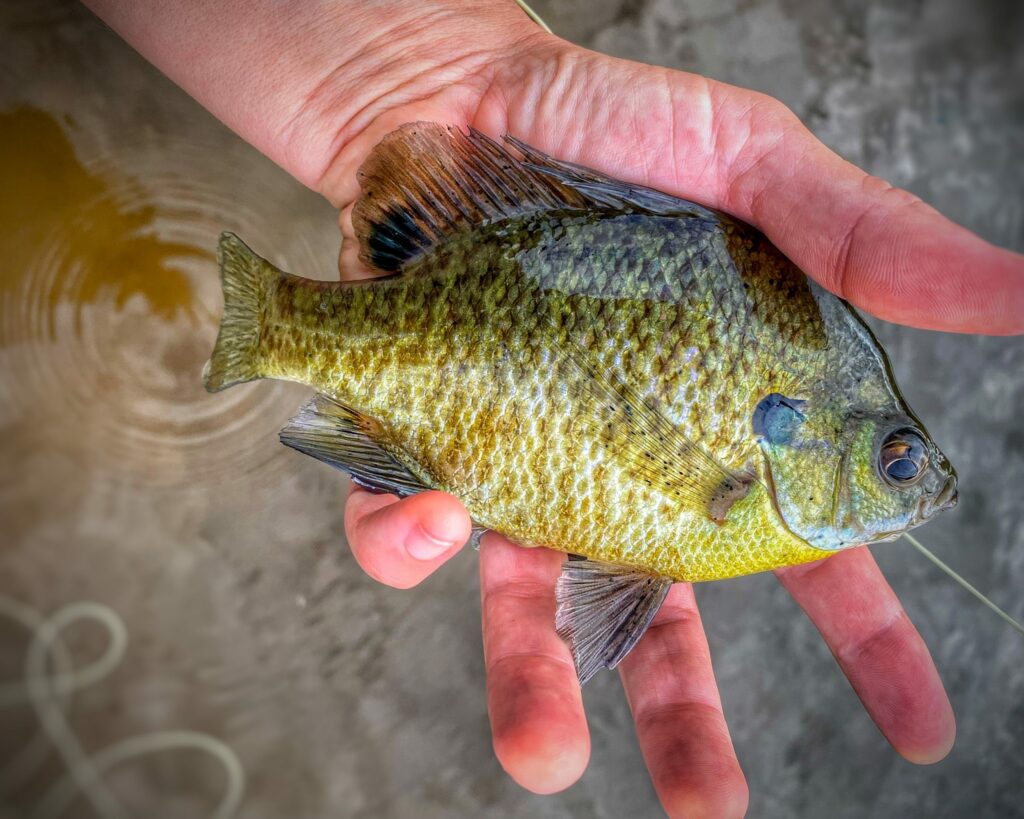
I then trekked around, just as I had months prior, to access the little peninsula on the other side. This time, while the oaks’ draping branches still provided a lovely lodge-like canopy, gone or cut and pushed aside were their fallen comrades. More than just the trail had changed. In the Spring, fresh, young, green grasses skirted the little landmass to a height just above the ankle. In the time since, they had grown 3 feet, turned to gold, and nearly engulfed it. I trod the slim trail to its point and to the 3 or 4 small offshoots of it that provided additional access points to cast. I was rewarded with a few more fish, but they were smaller, amounting to barely more than fry. By this time, the sun was teetering on the horizon, and I thought it best to head back to my original spot on the other side. This would have me casting there during whatever rise there might be at dusk and also leave me closer to the trail leading back to the van.
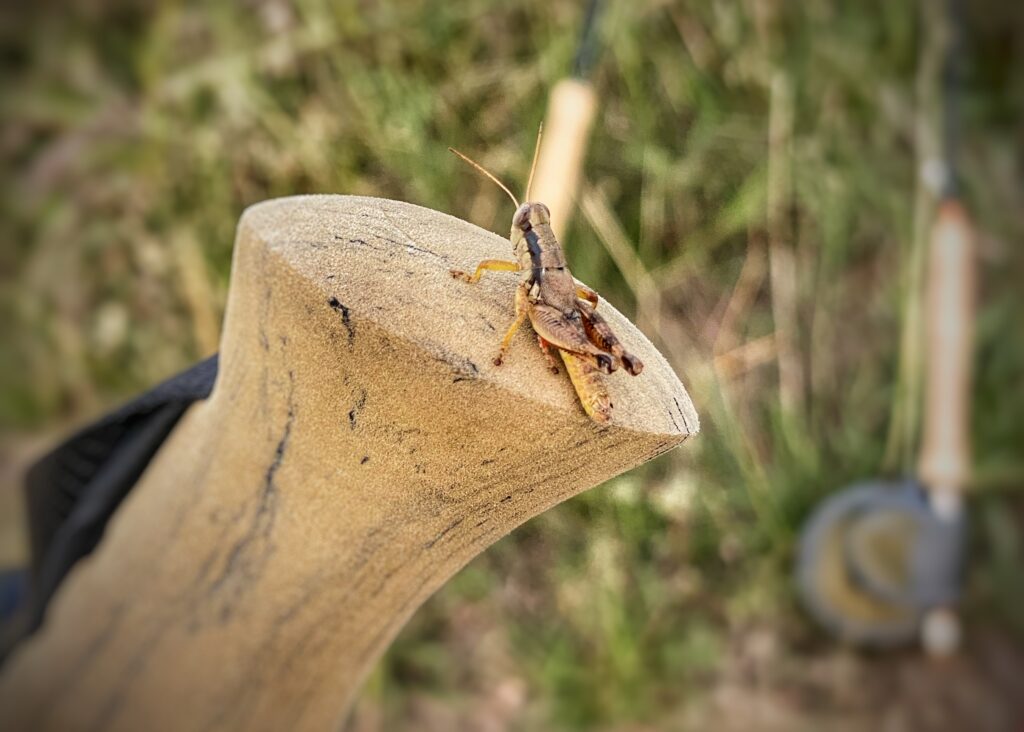
Employing the same tactics as before, I was able to land several more on that little ant. But the bite began to slow, a sure indicator that the jig was up. One tactic that can be effective in such a scenario, assuming you still have something in your fly box that looks tasty, is to change flies. While hanging out in the nest of grasses across the pond, I had seen several hoppers still about, so I plucked one of the small ones I had picked up for Colorado creek season this past summer from my fly box.
By the time I finished squinting and fumbling to attach fly to tippet in the gathering darkness, the sun grew tired of waiting and headed for bed. But it still yawned just enough of its yellow glow above the horizon line for another cast or two by sight. I proceeded to stretch one out and up under one of the tufts of vegetation as before and waited. No takers. I carefully retrieved it with a periodic and subtle twitch, willing my little bug puppet to convincingly play the part of desperate, struggling insect. About 3 feet into this slow dance, the surface shattered and then boiled. This was no panfish slurp, and while devoid of acrobatics, it was a hit that had all of the makings of a bass strike. Could it be? Were there bass here? Sure enough, after a few attempts to run, a small but respectable spotted bass filled the net, a giggle tickled my throat, and a grin painted my face.
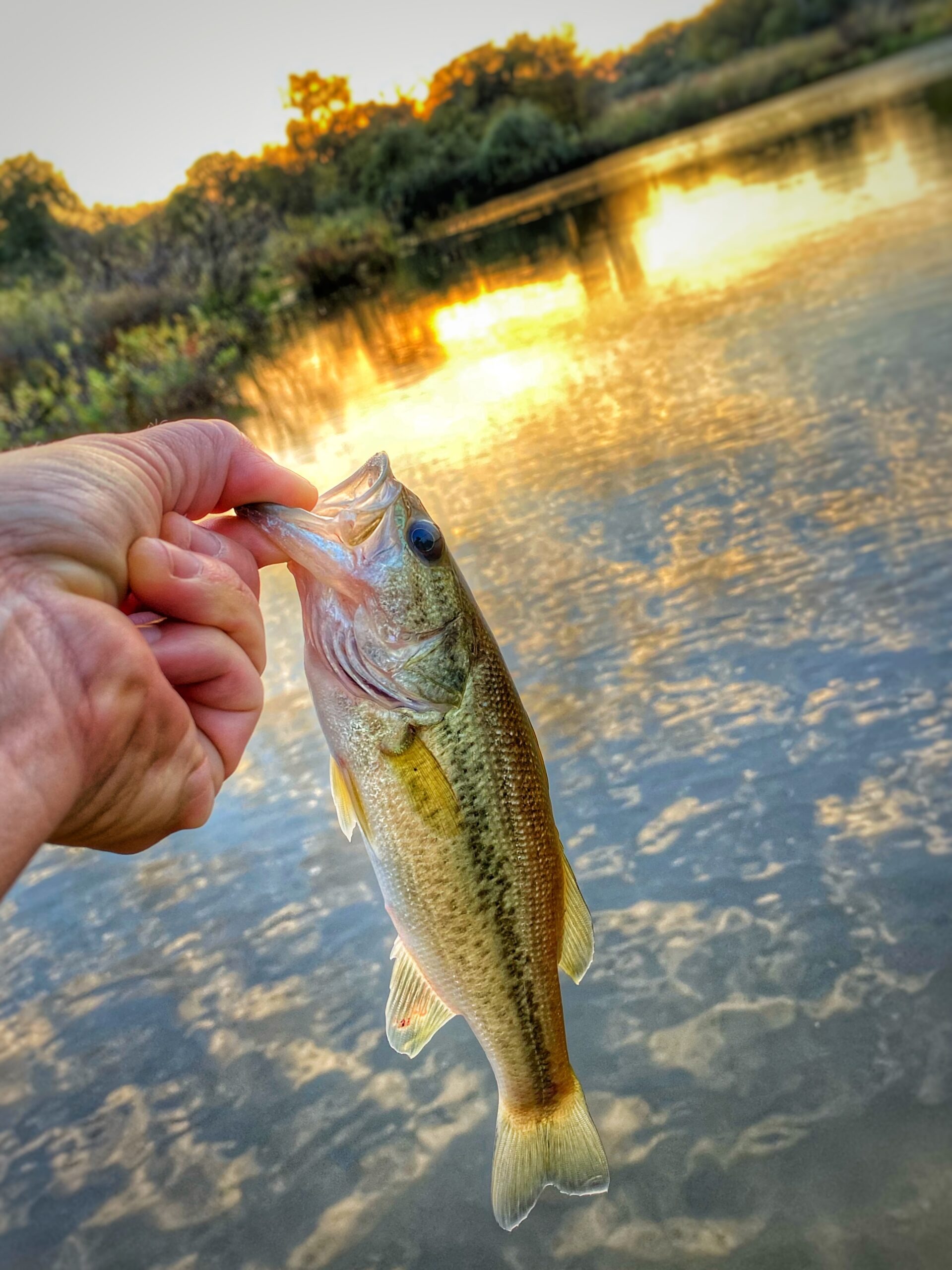
Over the course of my solitary hike out, I began to reflect on the day’s experience. Until the day proved that it wasn’t quite finished serving them up and introduced me to a diamondback stretched nearly halfway across the road-wide trail. Thankfully, the lightly colored, crushed granite had provided enough contrast in the mounting darkness for me to avoid stepping on or over it. I stepped back. Way back. If it’s possible to slowly do something quickly, or quickly do slowly, that’s what I did. Once I was a safe distance away, I blindly stabbed a hand into the abyss of my pack to rummage for my headlamp, all the while keeping a straining eye on my unexpected trail companion.
By this point, the snake had neither moved nor made a sound. Was it dead? I stared hard watching for the slightest indication of life as I groped for the power button to light my finally-liberated torch. I clicked to the brightest setting and aimed it the 15 yards or so down trail just in time to witness the creature’s silent slither into the tall grass. I then proceeded to stand like a statue in the middle of the trail for several minutes wondering if it was truly gone and, even so, if it had friends or family nearby. I now understand that the rattlers here in Hill Country have recently taken frequently to silence. You see, wild boars simply love a rattlesnake snack, and what serves as fair warning to some creatures might as well be dinner bell to others.
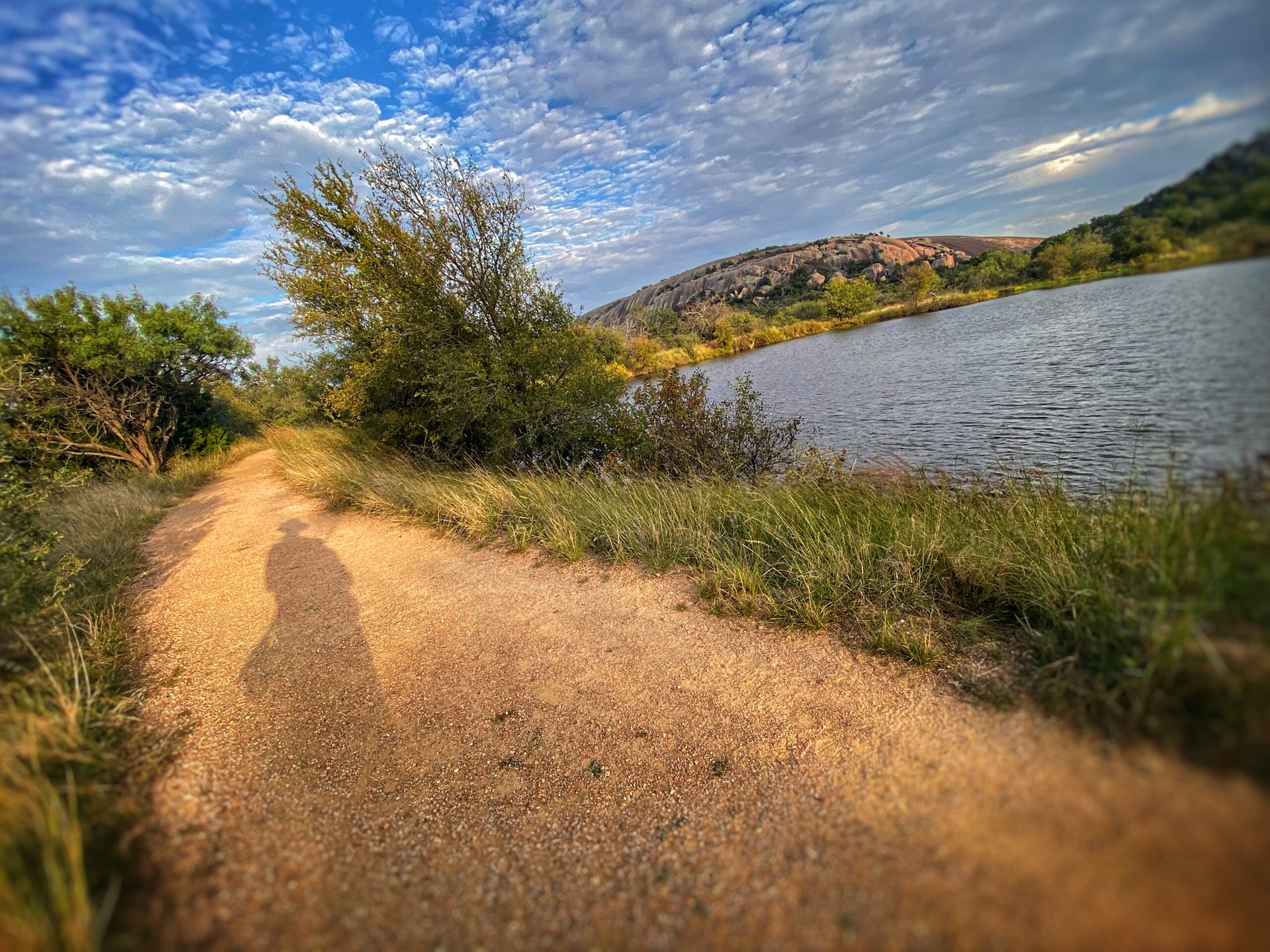
Eventually, I gathered up my resolve, dusted off my pack, and resumed the trek back to the #CariVan—headlamp strapped tight around my noggin and mobile phone playing a Patty Griffin tune as loud as the petite speakers would blare. For the record, I’m not a fan of spinning tunes in the backcountry but did so in this case as a means to broadcast my location to any other of the rather toothy nocturnes likely to be about.
Once back into the rhythm comprised of the alternating tick of trekking pole and crunch of footfall, my reflective posture resumed. I thought about how there are lots of folks who would think hiking four miles round trip to catch a few “dinks” in a “tank” was a fool’s errand. And then I thought about all of the other little experiences I “caught” because I endeavored to make the trip. The crisp Fall breeze caressing my face, the cool water drawing rings around my calves, the song of the crickets in my ears, and the thousands of colors in a Texas sunset flooding through the windows of my eyes. Reflected by the silvery-green scales of a bonus bass, by the way, is a lovely way to take in a sunset.
I descended the last hill, welcomed by the flicker of a half dozen campfires twinkling in the distance, I took a slow, deep breath and drew in the peace of it. The wonder of it. And felt it all the more for having allowed myself to simply fall into the arms of all creation as they drew me in and held me close. At that, my heart swelled and sang a little at the remembrance. It’s still humming that tune as I pen this account. Truth is, I tell these stories as much to relive them as I do to share them. Speaking of reliving, I think it might be time to plan trip number three to this lovely spot. So I might finally get a chance to fish it in the Springtime.


